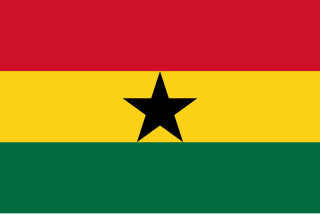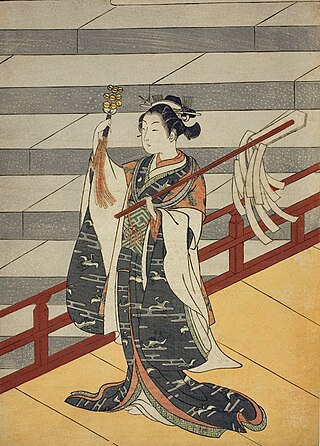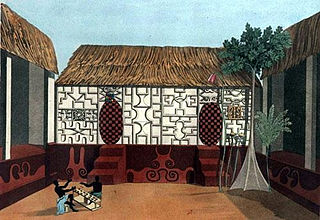Kami are the deities, divinities, spirits, mythological, spiritual, or natural phenomena that are venerated in the Shinto religion. They can be elements of the landscape, forces of nature, beings and the qualities that these beings express, and/or the spirits of venerated dead people. Many kami are considered the ancient ancestors of entire clans. Traditionally, great leaders like the Emperor could be or became kami.

A priest is a religious leader authorized to perform the sacred rituals of a religion, especially as a mediatory agent between humans and one or more deities. They also have the authority or power to administer religious rites; in particular, rites of sacrifice to, and propitiation of, a deity or deities. Their office or position is the "priesthood", a term which also may apply to such persons collectively. A priest may have the duty to hear confessions periodically, give marriage counseling, provide prenuptial counseling, give spiritual direction, teach catechism, or visit those confined indoors, such as the sick in hospitals and nursing homes.

Vodún or vodúnsínsen is an African traditional religion practiced by the Aja, Ewe, and Fon peoples of Benin, Togo, Ghana, and Nigeria. Practitioners are commonly called vodúnsɛntó or Vodúnisants.

A fetish is an object believed to have supernatural powers, or in particular, a human-made object that has power over others. Essentially, fetishism is the attribution of inherent non-material value, or powers, to an object. Talismans and amulets are related. Fetishes are often used in spiritual or religious context.

A libation is a ritual pouring of a liquid as an offering to a deity or spirit, or in memory of the dead. It was common in many religions of antiquity and continues to be offered in cultures today.

Ghana is a country of 33.48 million people and many native groups, such as:
The Akan people of Ghana, Ivory Coast and Togo frequently name their children after the day of the week they were born and the order in which they were born. These "day names" have further meanings concerning the soul and character of the person. Middle names have considerably more variety and can refer to their birth order, twin status, or an ancestor's middle name.
The Efutu are a part of the Guang people who are historically known to be the aboriginal inhabitants of present-day Ghana. They founded the coastal area about 1390 C.E. The Efutu are found in Awutu, Adina, Senya-Beraku and Winneba and their main occupation is fishing. Their mighty Guan culture have had influence on neighbouring Akan cultures.Akans,especially the borbor Mfantsefo had adopted their names and some cultural elements and fused it with theirs through integration to produce modern cultures which is shared by both the Guan people of Winneba and their Akan neighbours.However,Efutu just like other Guans states have a patrilineal system of succession. The Simpa Kingdom was formed about 1400 AD.

Ritual servitude is a practice in Ghana, Togo, and Benin where traditional religious shrines take human beings, usually young virgin girls, in payment for services or in religious atonement for alleged misdeeds of a family member. In Ghana and in Togo, it is practiced by the Ewe people in the Volta region; in Benin, it is practiced by the Fon.

Kagura is a type of Shinto ritual ceremonial dance. The term is a contraction of the phrase kami no kura, indicating the presence of gods in the practice.

The continent of Africa is one of the regions most rife with contemporary slavery. Slavery in Africa has a long history, within Africa since before historical records, but intensifying with the trans-Saharan and Indian Ocean slave trade and again with the trans-Atlantic slave trade; the demand for slaves created an entire series of kingdoms which existed in a state of perpetual warfare in order to generate the prisoners of war necessary for the lucrative export of slaves. These patterns persisted into the colonial period during the late 19th and early 20th century. Although the colonial authorities attempted to suppress slavery around 1900, their attempts were largely ineffective. Even after decolonization, slavery continues in many parts of Africa despite being officially illegal.

Christianity is the largest religion in Ghana, with 71.3% of the population belonging to various Christian denominations as of 2021 census. Islam is practised by 19.9% of the total population. According to a report by the Pew Research, 51% of Muslims are followers of Sunni Islam, while approximately 16% belong to the Ahmadiyya movement and around 8% identify with Shia Islam, while the remainder are non-denominational Muslims. Traditional religions such as the Akan Traditional Religion and Dagbon Traditional Religion are indigenous. Islam was the first Abrahamic religion to be introduced in the country between the tenth and 15th centuries, by Muslim traders. Later, Christianity was introduced via contact with the European missionaries. Christianity is mainly in the country's south while Islam is based in the north. Islam gained widespread acceptance in northern Ghana after Yaa Naa Zanjina accepted the faith in the 17th century.
The Akan people appear to have used a traditional system of timekeeping based on a six-day week. The Gregorian seven-day week is known as nnawɔtwe (eight-days). The combination of these two system resulted in periods of 40 days, known as adaduanan.
The Apoo Festival is a festival celebrated annually in western Ghana, lasting a week in March and April. The festival is meant to ritually purify the people of social evils, as well as uniting people and families, and includes a variety of other traditional cultural activities. The word 'apoo' comes from the root word 'po', meaning 'to reject.'

The Asante Traditional Buildings are a collection of 10 traditionally built buildings from the time of the Ashanti Empire in the area near Kumasi. These buildings served as fetish houses and shrines during the 18th and 19th centuries, during the golden age of the Ashanti Empire. When the empire fell during the British occupation of the area from 1806 to 1901, most Asante buildings of the period were destroyed during the era. Among other buildings, the royal mausoleum was destroyed by Robert Baden-Powell in 1895. The 10 remaining buildings are the last remains of the history and culture of the Asante people and were inscribed on the UNESCO World Heritage List in 1980.

Akan religion comprises the traditional beliefs and religious practices of the Akan people of Ghana and eastern Ivory Coast. Akan religion is referred to as Akom. Although most Akan people have identified as Christians since the early 20th century, Akan religion remains practiced by some and is often syncretized with Christianity. The Akan have many subgroups, so the religion varies greatly by region and subgroup. Similar to other traditional religions of West and Central Africa such as West African Vodun, Yoruba religion, or Odinani, Akan cosmology consists of a senior god who generally does not interact with humans and many gods who assist humans.
The Fetu Afahye is a festival celebrated by the chiefs and people of Cape Coast in the Central region of Ghana. The festival is celebrated on the first Saturday in the month of September every year. The Oguaa people of Cape Coast celebrate the Fetu Afahye every year because there was once a disease outbreak among the populace that resulted in a large number of fatalities. The people prayed to the gods to help them get rid of the disease. Thus the festival is celebrated to keep the town clean and to prevent another epidemic befalling the people.

Witch camps are settlements where women in Ghana who have been accused of being witches can flee for safety. Women in such camps have been accused of witchcraft for various reasons, including mental illness. Some camps are thought to have been created in the early 20th century. The Ghanaian government has enacted measures to eliminate such camps.

Vodun art is associated with the West African Vodun religion of Nigeria, Benin, Togo and Ghana. The term is sometimes used more generally for art associated with related religions of West and Central Africa and of the African diaspora in Brazil, the Caribbean and the United States. Art forms include bocio, carved wooden statues that represent supernatural beings and may be activated through various ritual steps, and Asen, metal objects that attract spirits of the dead or other spirits and give them a temporary resting place. Vodun is assimilative, and has absorbed concepts and images from other parts of Africa, India, Europe and the Americas. Chromolithographs representing Indian deities have become identified with traditional Vodun deities and used as the basis for murals in Vodun temples. The Ouidah '92 festival, held in Benin in 1993, celebrated the removal of restrictions on Vodun in that country and began a revival of Vodun art.
Juliana Dogbadzi is a Ghanaian human rights activist who has received the Reebok Human Rights Award.











